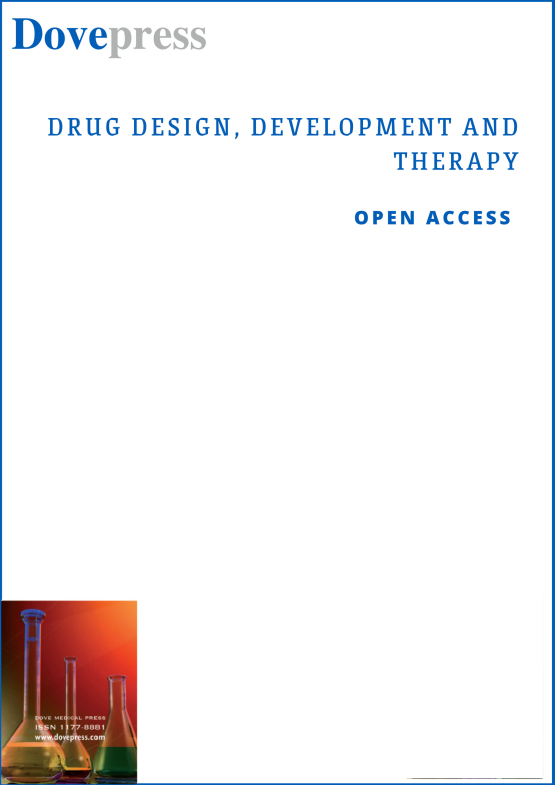Submit a Manuscript to the Journal
Drug Design, Development and Therapy
For an Article Collection on
Modern Computational Approaches for Drug Design and Discovery
Manuscript deadline


Article collection guest advisor(s)
Dr. Tamer M Ibrahim Abdelrehim,
Kafrelsheikh University
tamer.ibrahim2@gmail.com
Dr. Muzammal Hussain,
New York University
hmuzammal0404@gmail.com
Dr. Ahmed Elkerdawy,
University of Lincoln
aelkerdawy@lincoln.ac.uk
Dr. Frank M. Böckler, Editor in Chief,
Eberhard Karls University Tübingen
frank.boeckler@uni-tuebingen.de
Modern Computational Approaches for Drug Design and Discovery
Computer-aided drug design (CADD) is a fundamental component of contemporary drug discovery. CADD methods are generally divided into two main categories: Structure-Based Drug Design (SBDD) and Ligand-Based Drug Design (LBDD). The swift advancements in crystallography and homology modelling have greatly improved structure-based virtual screening, facilitating the effective identification of potential drug candidates in the initial stages of drug discovery. Furthermore, the rise in accessible computational power has enhanced the implementation of traditional in silico drug design and discovery methods, allowing for the rapid screening of extensive chemical libraries. CADD methods have garnered significant attention due to their ability to expedite drug discovery while reducing time, labour, and costs. They have emerged as a crucial driving force in drug discovery across both academic and industrial sectors.
Recently, this field has experienced remarkable advancements, largely fuelled by the progress of artificial intelligence (AI) including both machine learning and/or deep learning in drug discovery initiatives. The increasing availability of experimental data has facilitated the creation of highly precise AI models, which have a wide range of applications, including predicting the pharmacological activities of molecules, conducting ADME/T profiling, and forecasting molecular properties.
This Collection seeks to gather the most recent advancements in the development and application of computational methods for drug design and discovery, along with their application in preclinical research. We invite submissions from all relevant fields of study, including but not limited to:
- de novo drug design
- lead optimization
- virtual screening methodologies
- AI models to predict molecular activities/properties
- ADME/T property prediction
The collection is primarily open to original research articles, as well as reviews and perspectives.
The deadline for submissions is 31 October 2025. Please review the journal’s aims and scope and author submission instructions prior to submitting a manuscript.
Please submit your manuscript on our website, quoting the promo code NHJSD to indicate that your submission is for consideration in this Article Collection. Please note the standard Article Processing Charge will apply.
Please contact Haoyang Yi (Commissioning Editor) at haoyang.yi@taylorandfrancis.com with any queries regarding this Article Collection.
Guest advisors
Dr. Tamer M Ibrahim Abdelrehim, Kafrelsheikh University
Tamer M. Ibrahim Abdelrehim is an Associate Professor of Pharmaceutical Chemistry in the Faculty of Pharmacy, Kafrelsheikh University, Egypt. Prof. Abdelrehim’s research interest includes enhancing the performance of Structure-Based Virtual Screening workflows and fighting infectious diseases using Computer-Aided Drug Design (CADD) methodologies, and Medicinal Chemistry synthesis approaches.
Dr. Muzammal Hussain, New York University
Muzammal Hussain is currently a Postdoctoral Fellow at the New York University Grossman School of Medicine, where his research focuses on targeted protein degradation and drug discovery aimed at addressing challenging disease targets. His interests include structure-based drug design, modeling and analysis of ligand-protein interactions, phenotypic and virtual drug screening, and investigating drug mechanisms and signaling pathways.
Dr. Ahmed Elkerdawy, University of Lincoln
Dr. Ahmed Elkerdawy earned his doctoral degree from the University of Erlangen–Nuremberg - Germany with a specialization in Computer-aided Drug Design (CADD) in the Computer-Chemistry-Centre (CCC) research group. Dr. Elkerdawy has a unique blend of experiences in synthetic chemistry and CADD. He published more than 70 papers dealing with using computer-aided drug design approaches for lead discovery and lead optimization for new targets in the treatment of serious health problems like cancer, Alzheimer’s, and inflammation.
Dr. Frank M. Böckler, Eberhard Karls University Tübingen
At the Institute of Pharmaceutical Sciences, Frank Böckler heads the laboratory of Molecular Design & Pharmaceutical Biophysics, which combines Chemical Biology, Molecular and Structural Biology and Biophysics, as well as Computational Chemistry, Machine Learning and Molecular Design. In addition, he is a member of the Institute for Bioinformatics and Medical Informatics (IBMI). His work is dedicated to understanding molecular interactions, such as halogen and chalcogen bonds, as the foundation for chemical biology and drug discovery and to apply theoretical, fragment-based, biophysical and structural methods to cancer research, particularly involving the human kinome and the network of the tumor suppressor p53.
Benefits of publishing open access within Taylor & Francis
Global marketing and publicity, ensuring your research reaches the people you want it to.
Article Collections bring together the latest research on hot topics from influential researchers across the globe.
Rigorous peer review for every open access article.
Rapid online publication allowing you to share your work quickly.
Submission Instructions
All manuscripts submitted to this Article Collection will undergo desk assessment and peer-review as part of our standard editorial process. Guest Advisors for this collection will not be involved in peer-reviewing manuscripts unless they are an existing member of the Editorial Board. Please review the journal Aims and Scope and author submission instructions prior to submitting a manuscript.
